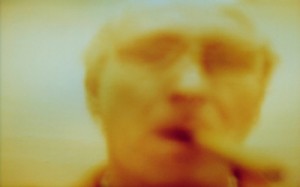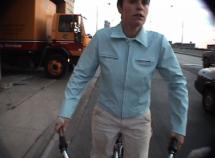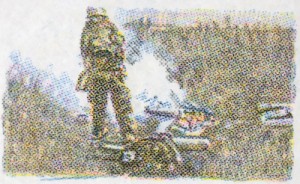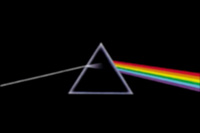
Presented at the International Film Festival Rotterdam January/February 2006
Are You Clean?
When I hear the words of these artists it makes me want to talk again: for now, it’s enough to lie back and let them run all over its viewer. And when these artists are not conjuring meta-anthropologies (all of this is documentary based, but strained through the first person and above all beautiful, it’s so damn beautiful to see) they are busy looking. Making a place to look from. Finding the distance, gauging the distance where the refusal of pictures (which is the hallmark of most movies, which are content to deliver pixels, or place holders, figments from the image plane, but which never arrive at a single picture) is at last swept away.
What Talking Means by Mike Cartmell 7.5 minutes 2006
The Mendi by Steve Reinke 9 minutes 2006
Draft 9 by Dani Leventhal 28 minutes 2003
The Quick and the Dead by Stephen Andrews 1.5 minutes silent 2004
Su Naa (My Big Brother) by Helen Haig-Brown 11:27 minutes 2005
Ask the Insects by Steve Reinke 8 minutes 2005
Total running time: 64 minutes
What Talking Means by Mike Cartmell 7.5 minutes 2006
How awfully close she is, so close I can see the breath she takes the way she holds that cigarette, the way her look drifts out over the lens without saying It, the thing she’s holding on, the way her talking never quite manages to arrive, to enter you like a knife, and yet she takes you apart all the same. The unspoken, the stutter, the place between words, could this also be a movie? It can, it has, it must. This personal essay missive by Mike Cartmell is part of a suite of fragments which comprise his epic work-in-progress Shipwreck Theory.
The Mendi by Steve Reinke 9 minutes 2006
The latest missive from Canadian vid genius Reinke finds him recovering an errant CBC documentary and finding a new way to look at it by working on the soundtrack. He sees with his ears, with his mouth. He applies his mouth to this footage, he gives it mouth to mouth, so now it can be seen again. This movie is very much in the tradition of Trinh T. Min-Ha, especially her early, interventionist, meta-anthropological work like Re:assemblage. His fearlessness makes me wonder: how could he? How does he dare?
Draft 9 by Dani Leventhal 28 minutes 2003
This movie was collected for four years before being sprayed scattershot over 28 minutes of psychic mayhem. The line between living and dead is a frontier crossed and re-crossed here. The living are dead while the dead are animated, breathing, swimming, giving birth. Consumed by the animal life of the city, the artist undertakes a first person journey, producing diary notes from one of the most skilled lens masters of the new generation. The camera is her company in this duet of death, the instrument that permits her to see the impossible, the unbearable, the invisible.
The Quick and the Dead by Stephen Andrews 1.5 minutes silent 2004
Against the white blank of too much light, having seen too much, and gone too far, the artist rescues a vision of immolation, standing at the brink of terror, and renders it beautiful. Only someone who has gone through a war of his own, in his own body, could have nursed these pictures with this much tenderness, could have brought to these scenes of the Iraq war so much intimacy, and moved them through his hands slowly and carefully, so that out of this data, these digits, this noise from abroad, there might arrive at last an image.
Su Naa (My Big Brother) by Helen Haig-Brown 11:27 minutes 2005
Derrida said it and now he’s dead too: when something is missing language speaks. The picture enters only too late, trying to cover the wound, to mark the place, the occasion, the words that might have, should have, the touch we didn’t, the face that isn’t any longer. Beginning in a howl of outrage this elegantly drafted videopoem runs up all of her feelings into the light and thoughtfulness and changing shadows and recast snowy rides and phone calls with dad and pump action beer cans and if it hurts and it’s beautiful at the same time and the rhythm of the dance of edits and light brings us right into the present it’s because that’s where she’s already waiting for us. Not nostalgia, not the good old days, but a memory carved out of the present, like a scar.
Ask the Insects by Steve Reinke 8 minutes 2005
Part home-made science (before it became doctrine and law), part animated video reverie, Reinke’s brief and episodic compression is an incendiary release which opens by announcing the death of the reader, of any audience capable of pulling its fragments together, or better, of dissolving into its tissues, of allowing the body to change shape, to identify, for instance, with an insect. Or a stone. It begins with the death of the reader and ends with the death of the author, and between he stops along the way to muse on rain falling up, the “useless bio-dioversity” of insects (meaning life is mostly decoration), signal deconstruction and beautiful noise, and burning books. His style is abrupt and associative, he jumps and jumps again, producing these small beautiful abysses which no one can see. He has produced something invisible to treasure, an impossible movie, which refuses to adhere to memory’s sound-byte continuums. It is waiting for a new body to store or restore it. And while it is waiting it speaks, like a lover on the phone. “ Whenever the rain falls, it knows it will rise again, and not full of dissolved impurities, but distilled to its essence, particles loose and moist, rising inexorably heavenward to join the endlessly protean cloud-cover, like a graveyard where all the stones have your name on them.”





